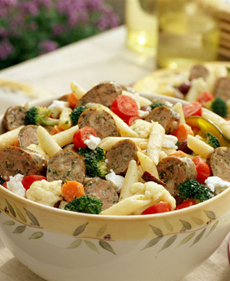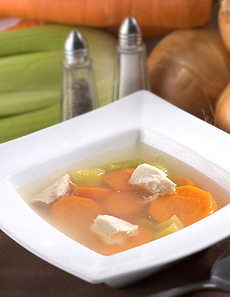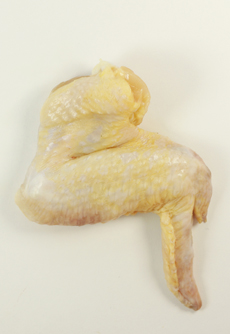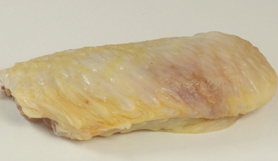Chicken Glossary: A Glossary Of The Different Chicken TypesPage 7: Chicken Terms S To Z This is Page 7 of an 7-page article. Click on the red links below to visit other pages. This glossary is protected by copyright and cannot be reproduced in whole or part. You are welcome to link to it.
|
 Roast coriander chicken thighs with sweet potatoes and bacon. Photo courtesy McCormick. Get the recipe. |
|
| SAUSAGE Chicken sausage typically has less fat than pork sausage, yet all the flavor. It’s flexible enough to be enjoyed with eggs at breakfast, in a hot dog roll at lunch, in a pasta salad, in a mixed grill, in stuffing or anyplace you’d use sausage. |
||
| SHANK The part of a chicken’s leg between the claw and the first joint. |
||
| SPRING CHICKEN or SPRINGER A a young and tender chicken, typically from two to ten months old. As chickens age, the flesh grows tougher and needs to be stewed (the original slow cooking) in order to be easily chewed. Not to be confused with poussin, or baby chicken. Also see stewing chicken.
|
 Chicken & Apple Sausage pasta salad. Photo courtesy Aidells. Get the recipe. |
|
| SPURS The sharp pointed protrusions on a rooster’s shanks.
|
||
| STAG A cockerel on the brink of sexual maturity, when his comb and spurs begin to develop.
|
||
| STANDARD The description of an ideal specimen for its breed; also, a chicken that conforms to the description of its breed in the American Standard of Perfection, sometimes erroneously used when referring to large as opposed to bantam breeds.
|
||
| STARTED PULLETS Young female chickens that are nearly old enough to lay. |
||
| STRAIGHTBRED Purebred.
|
||
| STEWING HEN A stewing hen is an older bird: 10 months to 1-1/2 years in age. Past its prime for roasting, it gave rise to the expression “tough old birds.” While no longer tender, the flesh still has plenty of flavor, and is a bargain when used to make a slow-cooked chicken stew, chicken soup or chicken stock.
|
||
| STRAIN A flock of related chickens selectively bred by one person or organization for so long that the offspring have become uniform in appearance or production.
|
 Use an older “stewing hen” to make stew or chicken soup. Photo courtesy Grandma’s Chicken Soup. |
|
| TENDER or TENDERLOIN Chicken tender or tenderloin is the inner breast meat (white meat) connected to the breastbone. Thinner than the rest of the breast, it is cut from the breast by the butcher. Sometimes the tender is called a cutlet, sometimes the outer breast meat is erroneously called a cutlet.
|
||
| THREE PART WING See wing, below. |
 The tender or tenderloin: the thinnest part of the breast. Photo by Elvira Kalviste | THE NIBBLE. |
|
| THIGH The thigh is the top portion of the leg that is attached to the body (see chicken cuts chart). Below the knee joint are the drumstick and the feet. The thigh (as well as the drumstick) consists of all dark meat. Thighs are available skinned as well as skinned and boned, a dark meat alternative to the boneless breast. |
 A skinned chicken thigh. Photo by Elvira Kalviste | THE NIBBLE. |
|
| VARIETY Subdivision of a breed of chicken according to color, comb style, beard and/or leg feathering.
|
||
| WATTLES The two red or purplish flaps of flesh that dangle under a chicken’s or rooster’s chin, as shown in the photo at right.
|
||
| WHOLE CHICKEN The entire bird, minus the head and the feet. The giblets are usually tucked inside. The top of the bird (breast quarters) is white meat; the bottom of the bird (leg quarters) is dark meat.
|
 A Rhode Island Red rooster and hen with bright red wattles. Photo by Andrei Niemimäki | Wikimedia. |
|
| WING or THREE PART WING
The wing of a chicken, which is white meat, comprises three parts:
WINGETTE
|
 Three part wing: shoulder wing or drumette, mid joint wing or wingette and the wing tip. Photos by Elvira Kalviste | THE NIBBLE.
|
|
Last Updated May 2018
© Copyright 2005-2025 Lifestyle Direct, Inc. All rights reserved. All images are copyrighted to their respective owners.

